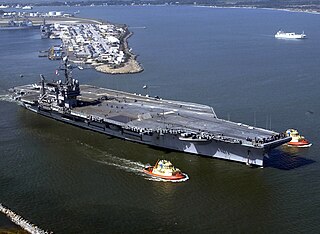
USS Kitty Hawk (CV-63), formerly CVA-63, is a decommissioned United States Navy supercarrier. She was the second naval ship named after Kitty Hawk, North Carolina, the site of the Wright brothers' first powered airplane flight. Kitty Hawk was the first of the three Kitty Hawk-class aircraft carriers to be commissioned and last to be decommissioned.

Kitty Hawk is a town in Dare County, North Carolina, and is a part of what is known as North Carolina's Outer Banks. The population was 3,272 at the 2010 Census. It was established in the early 18th century as Chickahawk.
USS Constellation may refer to:

USS John F. Kennedy (CV-67) is the only ship of her class and the last conventionally powered carrier built for the United States Navy. The ship was named after the 35th President of the United States, John F. Kennedy, and was nicknamed "Big John". John F. Kennedy was originally designated a CVA ; however, the designation was changed to CV.
USS America may refer to:

The Kitty Hawk-class supercarriers of the United States Navy were an incremental improvement on the Forrestal-class vessels. Three were built, all in the 1960s, Kitty Hawk (CV-63) (1961–2009), Constellation (CV-64) (1961–2003), America (CV-66) (1965–1996), as well as the variant John F. Kennedy (CV-67) (1967–2007). All are now decommissioned.

The New York Shipbuilding Corporation was an American shipbuilding company that operated from 1899 to 1968, ultimately completing more than 500 vessels for the U.S. Navy, the United States Merchant Marine, the United States Coast Guard, and other maritime concerns. At its peak during World War II, NYSB was the largest and most productive shipyard in the world. Its best-known vessels include the destroyer USS Reuben James (DD-245), the cruiser USS Indianapolis (CA-35), the aircraft carrier USS Kitty Hawk (CV-63), the nuclear-powered cargo ship NS Savannah, and a quartet of cargo-passenger liners nicknamed the Four Aces.
K-314 was a nuclear submarine of the Soviet Navy, of the type Project 671 "Ёрш".

USS Kitty Hawk (APV-1/AKV-1), formerly SS Seatrain New York, was a cargo ship that was converted into an aircraft transport during World War II.

Electronic Attack Squadron 136 (VAQ-136) also known as "The Gauntlets" is a United States Navy electronic attack squadron flying the EA-18G Growler and is currently attached to Carrier Air Wing Two, a composite unit made up of a wide array of aircraft performing a variety of combat and support missions. The squadron is currently stationed at Naval Air Station Whidbey Island.

Carrier Air Wing Five (CVW-5) is a United States Navy aircraft carrier air wing based at Marine Corps Air Station Iwakuni and Naval Air Facility Atsugi, Japan. The air wing is attached to the aircraft carrier USS Ronald Reagan. It was initially formed in 1943. It has participated in the Second World War, the Korean War, the Gulf War, Operation Southern Watch, the War in Afghanistan, and the War in Iraq.
Kitty Hawk or Kittyhawk may refer to:

Helicopter Sea Combat Squadron 14 (HSC-14) "Chargers" is an aviation unit of the United States Navy based at Naval Air Station North Island, California (USA). HSC-14 was established as Helicopter Anti-Submarine Squadron 14 (HS-14) in 1984 and was redesignated HSC-14 in 2013. The squadron is equipped with the Sikorsky MH-60S Seahawk.

Gringo-Gaucho are a contingent set of maneuvers performed between the Argentine Naval Aviation and United States Navy's aircraft carriers. The US Navy refers to them as Southern Seas in their last edition. Gringo and Gaucho are linguistic and folkloric designations of long standing, respectively.
Cannibalization of machine parts, in the maintenance of mechanical or electronic systems with interchangeable parts, refers to the practice of removing parts or subsystems necessary for repair from another similar device, rather than from inventory, usually when resources become limited. The source system is usually crippled as a result, perhaps only temporarily, in order to allow the recipient device to function properly again.

Fighter Squadron 1 (VF-1) was a fighter squadron of the United States Navy. Originally established on 14 October 1972 it was disestablished on 30 September 1993. It was the fifth US Navy squadron to be designated VF-1. Known as the "Wolfpack" the squadron saw combat during the Vietnam War and Operation Desert Storm. The squadron was de-activated and its personnel reassigned in 1993 when its carrier, USS Ranger, was decommissioned.
Several vessels have borne the name Kitty, a diminutive for the name "Catherine", and a name in its own right:
This page is based on this
Wikipedia article Text is available under the
CC BY-SA 4.0 license; additional terms may apply.
Images, videos and audio are available under their respective licenses.









